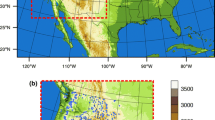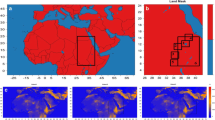Abstract
This paper presents results from a 40 year Weather Research and Forecasting (WRF) based dynamical downscaling experiment performed at 12 km horizontal grid spacing, centered on the state of California, and forced by a 1° × 1.25° finite-volume current-climate Community Climate System Model ver. 3 (CCSM3) simulation. In-depth comparisons between modeled and observed regional-average precipitation, 2 m temperature, and snowpack are performed. The regional model reproduces the spatial distribution of precipitation quite well, but substantially overestimates rainfall along windward slopes. This is due to strong overprediction of precipitation intensity; precipitation frequency is actually underpredicted by the model. Moisture fluxes impinging on the coast seem to be well-represented over California, implying that precipitation bias is caused by processes internal to WRF. Positive-definite moisture advection and use of the Grell cumulus parameterization result in some decrease in precipitation bias, but other sources are needed to explain the full bias magnitude. Surface temperature is well simulated in all seasons except summer, when overly-dry soil moisture results in a several degree warm bias in both CCSM3 and WRF. Additionally, coastal temperatures appear to be too warm due to a coastal sea surface temperature bias inherited from CCSM3. Modeled snowfall/snowmelt agrees quite well with observations, but snow water equivalent is found to be much too low due to monthly reinitialization of all regional model fields from CCSM3 values.
Article PDF
Similar content being viewed by others
Avoid common mistakes on your manuscript.
References
Bala G, Rood R, Mirin A, McClean J, Achutarao K, Bader D, Gleckler P, Neale R, Rasch P (2008) Evaluation of a CCSM3 simulation with a finite volume dynamical core for the atmosphere at 1° lat × 1.25° lon resolution. J Climate 21:1467–1486
Bell JL, Sloan LC, Snyder MA (2004) Regional changes in extreme climatic events: a future climate scenario. J Climate 17:81–87
Chin HS (2008) Dynamical downscaling of GCM simulations: toward the improvement of forecast bias over California. LLNL-TR-407576, Lawrence Livermore National Lab. https://e-reports-int.llnl.gov/pdf/365755.pdf, 16pp
Coquard J, Duffy P, Taylor K, Iorio J (2004) Present and future surface climate in the Western USA as simulated by 15 global climate models. Clim Dyn 23:455–472
Dai A (2006) Precipitation characteristics in eighteen coupled climate models. J Climate 19:4605–4630
Daly C, Gibson W, Taylor G, Johnson G, Pasteris P (2002) A knowledge-based approach to the statistical mapping of climate. Clim Res 22:99–113
Davies HC (1976) A lateral boundary formulation for multi-level prediction models. Q J R Meteorol Soc 102:405–418
Dudhia J (1989) Numerical study of convection observed during the winter monsoon experiment using a mesoscale two-dimensional model. J Atmos Sci 46:3077–3107
Dudhia J, Weisman ML, Skamarock WC, Wang W (2003) Studies of heavy rainfall in the United States with WRF. In: International workshop on NWP models for heavy precipitation in Asia and Pacific areas, Tokyo, 4–6 February 2003, pp 84–89
Duffy PB, Arritt RW, Coquard J, Gutowski W, Han J, Iorio J, Kim J, Leung L-R, Roads J, Zeledon E (2006) Simulations of present and future climates in the Western United States with four nested regional climate models. J Clim 19:873–895
Fowler HJ, Blenkinshop S, Tebaldi C (2007) Linking climate change modelling to impacts studies: recent advances in downscaling techniques for hydrological modeling. Int J Climatol 27:1547–1578
Fowler HJ, Ekstrom M, Kilsby C, Jones P (2005) New estimates of future changes in extreme rainfall across the UK using regional climate model integrations. 1. Assessment of control climate. J Hydrol 300:212–233
Giorgi F, Brodeur C, Bates G (1994) Regional climate change scenarios over the United States produced with a nested regional climate model. J Climate 7:375–399
Groisman P, Easterling D, Quayle R, Golubev V, Krenke A, Mikhailov A (1996) Reducing biases in estimates of precipitation over the United States: phase 3 adjustments. J Geophys Res 101:7185–7196
Hahn RS, Mass CF (2009) The impact of positive definite moisture advection in orography. J Atmos Sci (in press)
Hamlet AF, Lettenmeier DP (2005) Production of Temporally consistent gridded precipitation and temperature fields for the continental United States. J Hydrometeorol 6:330–336
Han J, Roads J (2004) U.S. climate sensitivity simulated with the NCEP regional spectral model. Clim Change 62:115–154. doi:10.1023/B:CLIM.0000013675.66917.15
Hayhoe K, Wake C, Anderson B, Liang X-Z, Maurer E, Zhu J, Bradbury J, DeGaetano A, Stoner A, Wuebbles D (2007) Regional climate change projections for the Northeast USA. Mitig Adapt Glob Change. doi:10.1007/s11027–007–9133–2
Hong S-Y, Noh Y, Dudhia J (2006) A new vertical diffusion package with an explicit treatment of entrainment. Mon Weather Rev 134:2318–2341
Kain J, Fritsch J (1990) A one-dimensional entraining/detraining plume model and its application in convective parameterization. J Atmos Sci 47:2287–2802
Kida H, Koide T, Sasaki H, Chiba M (1991) A new approach to coupling a limited area model with a GCM for regional climate simulation. J Meteorol Soc Jpn 69:723–728
Kim J (2005) A projection of the effects of the climate change induced by increased CO2 on extreme hydrologic events in the Western US. Clim Change 68:153–168
Kim J, Lee J-E (2003) A multiyear regional climate hindcast for the western United States using the mesoscale atmospheric simulation model. J Hydrometeorol 4:878–890
Kim J, Miller NL, Farrara JD, Hong S-Y (2000) A numerical study of precipitation and streamflow in the western United States during the 1997/1998 winter season. J Hydrometeorol 1:311–329
Leung LR, Ghan S (1999) Pacific Northwest climate sensitivity simulated by a regional climate model driven by a GCM. Part I: control simulations. J Clim 12:2010–2030
Leung LR, Qian Y, Bian X (2003) Hydroclimate of the western United States based on observations and regional climate simulations of 1981–2000. Part I: seasonal statistics. J Clim 16:1892–1911
Leung LR, Qian Y, Bian X, Washington W, Han J, Roads J (2004) Mid-century ensemble regional climate change scenarios for the western United States. Clim Change 62:75–113
Liang X-Z, Li L, Kunkel KE, Ting M, Wang JXL (2004) Regional climate model simulation of U.S. precipitation during 1982–2002. Part I: annual cycle. J Climate 17:3510–3529
Liang X-Z, Xie Z, Huang M (2003) A new parameterization for surface and groundwater interactions and its impact on water budgets with the variable infiltration capacity (VIC) land surface model. J Geophys Res Atmos 108(D16):8613. doi:10.1029/2002JD003090
Mass C, Ovens D, Westrick K, Colle B (2002) Does increasing horizontal resolution produce more skillful forecasts?. Bull Am Meteor Soc 83:407–430
Maxwell RM, Chow FK, Kollet SJ (2007) The groundwater-land-surface-atmosphere connection: soil moisture effects on the atmospheric boundary layer in fully-coupled simulations. Adv Water Resour 30:2447–2466
Maxwell RM, Miller NL (2005) Development of a coupled land surface and groundwater model. J Hydrometeorol 6:233–247
McGregor J (1997) Regional climate modeling. Meteorol Atmos Phys 63:105–117
Mlawer E, Taubman S, Brown P, Iacono M, Clough S (1997) Radiative transfer for inhomogenous atmospheres: RRTM, a validated correlated-k model for the longwave. J Geophys Res 102:16663–16682
Pan Z, Arritt R, Gutowski W Jr., Takle E, Otieno F (2001) Evaluation of uncertainties in regional climate change simulations. J Geophys Res 106:17735–17752
Pan Z, Takle E, Gutowski W, Turner R (1999) Long simulation of regional climate as a sequence of short segments. Mon Weather Rev 127:308–321
Salathe EP, Steed R, Mass CF, Zahn, PH (2008) A high-resolution climate model for the U.S. Pacific Northwest: mesoscale feedbacks and local responses to climate change. J Clim 21:5708–5726
Smirnova T, Brown J, Benjamin S (1997) Performance of different soil moisture configurations in simulating ground surface temperature and surface fluxes. Mon Weather Rev 125:1870–1884
Smirnova T, Brown J, Benjamin S, Kim D (2000) Parameterization of cold-season processes in the MAPS land-surface scheme. J Geophys Res 105:4077–4086
Snyder MA, Bell JL, Sloan LC (2002) Climate responses to a doubling of atmospheric carbon dioxide for a climatologically vulnerable region. Geophys Res Lett 29. doi:10.1029/2001GL014431
Solomon S, Qin D, Manning M, Chen Z, Marquis M, Averyt K, Tignor M, Miller H (eds) (2007) Climate change 2007: the physical science basis. Contribution of working group I to the fourth assessment report of the intergovernmental panel on climate change. Cambridge University Press, Cambridge, 996 pp
Stöckli R, Lawrence DM, Niu G-Y, Oleson KW, Thornton PE, Yang Z-L, Bonan GB, Denning AS, Running SW (2008) Use of fluxnet in the community land model development. J Geophys Res 113:G01025. doi:10.1029/2007JG000562
Thompson GR, Rasmussen RM, Manning K (2004) Explicit forecasts of winter precipitation using an improved bulk microphysics scheme. Part I: description and sensitivity analysis. Mon Weather Rev 132:519–542
Trenberth KE (1999) Atmospheric moisture recycling: role of advection and local evaporation. J Climate 12:1368–1381
von Storch H, Langenberg H, Feser F (2000) A spectral nudging technique for dynamical downscaling purposes. Mon Weather Rev 128:3664–3673
Wang Y, Leung LR, McGregor JL, Lee D-K, Wang W-C, Ding Y, Kimura F (2004) Regional climate modeling: progress, challenges, and prospects. J Meteorol Soc Jpn 82:1599–1628
Widmann M, Bretherton C (2000) Validation of mesoscale precipitation in the NCEP reanalysis using a new gridcell dataset for the northwestern United States. J Climate 13:1936–1950
Wilby R, Charles S, Zorita E, Timbal B, Whetton P, Mearns L (2004) Guidelines for use of climate scenarios developed from statistical downscaling methods. Technical report, IPCC Task Group on Data and Scenario Support for Impact and Climate Analysis (TGICA). www.ipcc-data.org/guidelines/dgm_no2_v1_09_2004.pdf
Yeh P, Eltahir E (2005) Representation of water table dynamics in a land-surface scheme. J Clim 18:1861–1880
York JP, Person M, Gutowski WJ, Winter TC (2005) Putting aquifers into atmospheric simulation models: an example from the Mill Creek watershed, northeastern Kansas. Adv Water Resour 25:221–238
Author information
Authors and Affiliations
Corresponding author
Rights and permissions
Open Access This is an open access article distributed under the terms of the Creative Commons Attribution Noncommercial License (https://creativecommons.org/licenses/by-nc/2.0), which permits any noncommercial use, distribution, and reproduction in any medium, provided the original author(s) and source are credited.
About this article
Cite this article
Caldwell, P., Chin, HN.S., Bader, D.C. et al. Evaluation of a WRF dynamical downscaling simulation over California. Climatic Change 95, 499–521 (2009). https://doi.org/10.1007/s10584-009-9583-5
Received:
Accepted:
Published:
Issue Date:
DOI: https://doi.org/10.1007/s10584-009-9583-5




